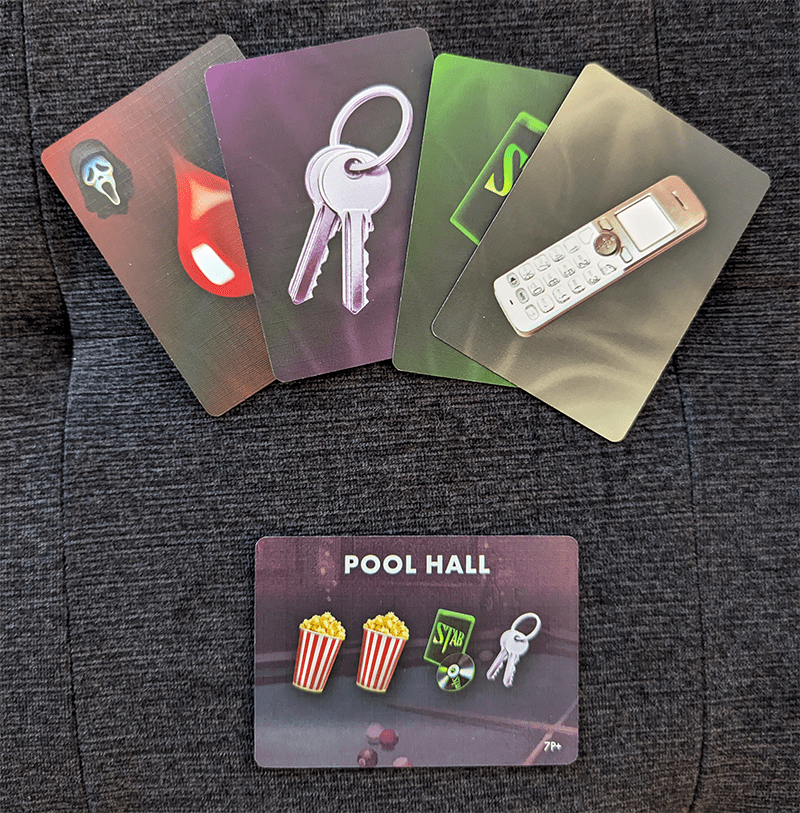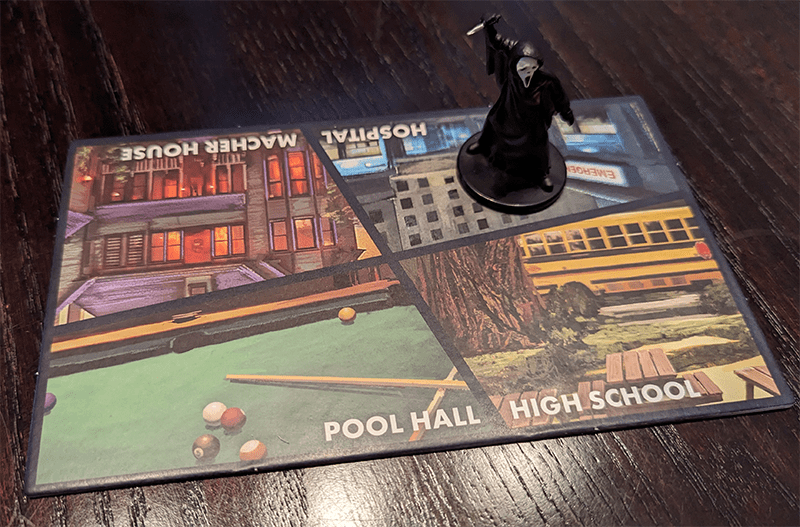Disclosure: Meeple Mountain received a free copy of this product in exchange for an honest, unbiased review. This review is not intended to be an endorsement.
Lights dim, suspense fills the air, and a faint whisper echoes through the room. For most, this would signal the beginning of a spine-chilling horror movie experience. But for those of us who are less inclined toward the macabre, the world of horror can often seem like uncharted territory.
As a self-proclaimed non-fan of horror movies, the adrenaline-fueled screams and jump scares never quite managed to capture my attention. My vivid imagination often takes hold of me, immersing me deeply in the violent scenes in these films and placing me in the shoes of the victim, regardless of our apparent differences.
Scream was one of my first horror movies, and I still remember that garage scene with the camera focusing on the gears before the final kill shot. The fact that I recall that tidbit after several decades is a bit of an endorsement. I can’t believe I just wrote “several decades.” I’m old.
Of course, this does lead to one particular question: Why the heck am I reviewing the Scream board game? Several reasons.

What’s Your Favorite Scary Movie?
It’s a set collection game, and like sex in horror movies, I never turn it down, even if the outcome will likely include my inevitable death. I like cards, hand management, and filling out objectives like I’m playing Rummy. This isn’t the first time I’ve reviewed a set collection game that was outside my interest. I don’t care for birds, and yet I reviewed Birdwatcher.
Additionally, this board game incorporates an app in a seamlessly integrated manner that enhances the gameplay without being intrusive, like many other app-based board games. Prepare to receive unexpected calls from Ghostface with a set of instructions and creative threats. If you are as old as me, this might sound familiar to you from another game called Nightmare, or Atmosfear to some of you, and it hits that memory mark with a watchmaker’s precision.
Now, you might wonder, why would an app provide instructions in a turn-based game? Scream has a time limit and will remind you constantly of that, making each turn last a few seconds while passing a cardboard knife around. I hope you and your friends are good at communication, especially since this is a cooperative game.
So what are we actually doing here? You and your fellow victims have a deck of Scene cards to go through. You start with one in front of you that lists the objects you need and the location you are in. In simple terms, it’s your personal objective. You also start with three object cards.
When it’s your turn, you are going to do one of the three actions: Draw, Trade, or complete the Scene card. Drawing means drawing one object card. Trade is when you trade a single object card with another player face down. Completing a Scene means discarding the object cards in your hand to remove the Scene card in front of you and draw another one. After doing your action, pass the knife to the player to your left.
Talk Less, Stab More
I’ve mentioned communication before because you are allowed to say whatever you like at any time, even when it’s not your turn. The only thing you cannot do is show the cards in your hand. Expect your fellow victims to chirp about what they need and what they have and offer suggestions that will likely be your game’s downfall.
As for our wonderful antagonist, Ghostface, he will make calls via the app and do one of the three actions.
Taunt is where everyone looks at the object cards in their hands. You see, some object cards will have Ghostface on them, and if your hand has three or more, you discard your entire hand.
Threaten is where he threatens a location. As mentioned previously, each Scene card has a location listed on it. The initial call is a heads-up that he’s heading there. The subsequent call is that he will make a demand for a single random object card. Unable to fulfill the demand? Bid farewell to your hand as it is discarded.
The pivotal and most crucial action Ghostface will perform is stalking. Ghostface selects a specific player and delivers a chilling message, alerting them of his imminent approach and making a demand. His demands are always a trio of objects, such as three keys or three popcorn cards. If he calls again and the player doesn’t have it, the player dies, and everyone loses.
Following the tradition of party games, Scream isn’t meant to be hard to digest. The rules are easy to explain, and the table presence is not intimidating. If anything, the cardboard knife will intrigue outside observers, who will wonder what is going on.

A Well-Earned Kill
As for the game itself, it’s a set collection game with real-time elements, so does this work? The answer is somewhere between yes and no, but I am leaning towards yes. Scream pleasantly surprised me with its clever game design. Initially, it may appear simple, but the inclusion of the app and its implications add a layer of subtle tension.
One aspect that caught me off guard was the incorporation of Ghostface on the object cards. Typically, card games impose a limit on the number of cards you can hold in your hand, but Scream ignores this heritage. Initially, I was curious about the reason behind this choice. However, my curiosity quickly turned to concern as my cards vanished from my grasp due to the Taunt calls. The Taunt serves as a gentle reminder of the number of cards you can hold, as having three Ghostface cards becomes a risky gamble. This system reminded me of the Robber rule in Catan and added pressure to the gameplay.
Discarding your hand, whether through force via the app or voluntarily by clearing a Scene card, can force you to walk the dark, abandoned road of unintended consequences. To give one easy scenario, you turn your cards in for a Scene card, only to have Ghostface call you out through a Stalk two seconds later, demanding three keys. “No big deal,” one might say, except it is.
You can only draw cards on your turn, as players cannot freely give cards to each other. Going through the scenario I just painted, imagine playing a game with six people. That means for you to even have three cards in your hand, that knife has to be passed eighteen times. Mind you, this is merely to have three cards in your hand; you still need keys, and you are under a time limit! Everyone will start communicating in panic, fumbling their words as well as that knife, and eventually getting themselves killed by their own incompetence.
These are the moments that propel Scream to its peak, captivating the entire table. What initially seems like a straightforward card-collecting game transforms into an exploration of human vulnerability as players’ emotions intensify in response to the unexpected calls from Ghostface. It is during these moments that I sometimes find myself assuming the role of an audience member, frustratedly shouting at the characters in the movie for their obvious and foolish decisions. Unlike other party games, Scream is skill-based, and here is where I highlight my reservations.

Time to Confess
I know I’m raising a few eyebrows with that statement, but give me a few sentences to understand my point. If you look at games like Telestration and Codenames, most of them aren’t truly skill-based. In Telestrations, players alternate between drawing and guessing what the picture is. Codenames force the spymaster to come up with single-word clues so their team doesn’t pick the wrong words from a grid of cards. Both of these games, as well as many party games, utilize the flaw of human interpretation as a driving force.
Scream shoves its hand at this tradition. There is nothing to interpret here, as the foundations of Scream’s experience are held by the player’s ability to manage their hand, emotions, and communications. In other words, Scream is begging the players to mess up instead of being designed for the players to eventually make mistakes. The app is merely there to throw a monkey wrench into a rather mundane system, and it sometimes works.
My viewpoint comes from the mixed experiences I’ve had with Scream. At lower player counts, such as 3 or 4, the game wasn’t as challenging as I hoped, as there was less collision of emotions due to fewer people. This isn’t to say the game is easy, as our brains and attention were at 100% due to the app, but to say this game delivers a consistent experience would be a lie. With an increase in the number of players, the game truly revealed its nature as the likelihood of someone mishandling the situation grew. This could manifest in various ways, such as by drawing an excessive number of cards or failing to pass the knife.
Since I am riding on this rail of criticism, the app could also use a few improvements. The sound mixing is off, as the voice is far quieter than it should be, even with Bluetooth speakers. While I certainly appreciate the gesture of the original voice actor involved in this, there need to be more lines. My biggest grievance has to be re-entering the names every time you restart, as it doesn’t remember names from the previous session. Even a calculator has some form of short-term memory.
While I have expressed some complaints about Scream, my overall enjoyment of the game far surpasses those concerns. As a fan of set-collection games, I appreciate the unique approach that Scream brings to the table. The clever design, the unexpected twists brought by Ghostface’s calls, and the intense moments of human fragility all contribute to a unique party game experience. It successfully emulates the basics of a horror movie trope through a simple ruleset. Like many horror films, it’s not flawless, but it is one of the few party games that gets it right.












Great review! I loved how you captured the tension and excitement of Scream. The gameplay mechanics sound unique and engaging, and I can’t wait to try it out with my friends. Your breakdown of the characters and their abilities really helps showcase the strategic depth of the game. Thanks for the insights!